Holiday learning
 {:style=“float: left; margin-right: 1em”} I’m in the middle of 3 weeks of annual leave. It’s great to just put work aside for a bit and take time to unwind. I’ve been out walking, cycling, drying apricots and making apricot jam, catching up with friends and family, amongst other things.
{:style=“float: left; margin-right: 1em”} I’m in the middle of 3 weeks of annual leave. It’s great to just put work aside for a bit and take time to unwind. I’ve been out walking, cycling, drying apricots and making apricot jam, catching up with friends and family, amongst other things.
I thought I’d use some of my time off get more familiar with Azure and GitHub and have been pleasantly surprised by the learning materials available over at docs.microsoft.com.
Learning content is organised in modules - these are self-contained units of work. Modules might be grouped together in a ‘Learning Path’. Some content relates to specific Microsoft exams, so if you’re interested in gaining a specific certification you can work back from the exam requirements to help ensure you’ve covered all the areas.
eg. To achieve the Microsoft Certified: DevOps Engineer Expert certification, after you’ve achieved one of the associate pre-requisites, you then need to pass Exam AZ-400: Designing and Implementing Microsoft DevOps Solutions.
One of the learning paths for this exam is AZ-400: Manage source control.
In that learning path is the module Manage software delivery by using a release based workflow on GitHub.
The GitHub-related content usually has an overview and some introductory content. Then they include a practical exercise which actually uses GitHub. These are cleverly done by automatically cloning a repository into your own GitHub account, and then stepping you through using GitHub issues (and sometimes pull requests) with automated responses updating the issues or moving you to the next step once you’ve performed the necessary steps. It’s really quite clever!
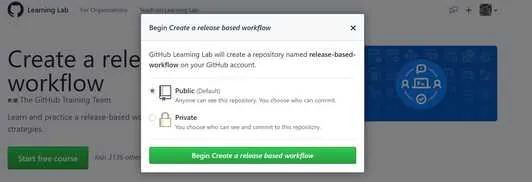
Now the repository has been created, you can click on Start to begin the process. As you complete each step it will be marked as complete (so you can come back to finish the exercise later if you don’t finish it in one sitting)
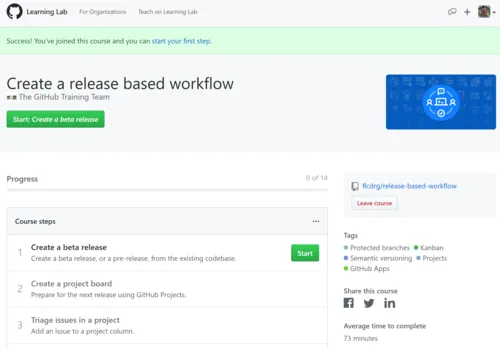
There’s some instructions to follow. I found it’s easiest to right-click on the link to open it in another tab, follow the instructions..
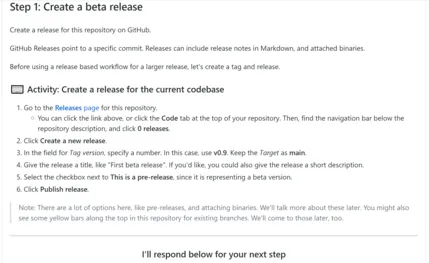
and then come back to this tab to wait for the next bit (which will be added as a comment to the issue)

Then click on the link to the next issue to follow on with the next step.
At the conclusion of the exercise, you head back to the docs site for a knowledge check with a multiple choice quiz to check that you’ve understood the main concepts for the module, and then you’re done!
Some modules covered concepts I was already familiar with so if I felt the practical exercise didn’t contain anything new then I’d just skip directly to knowledge check.
Azure learning modules are similar, except that instead of using GitHub, they often including access to temporary Azure resources. Some modules might embed an Azure cloud shell right in your browser on the same page as the instructions. Others will ask you to log in to the Azure Portal so you can follow through creating or manipulating resources there.
You’ll be asked to active the sandbox (and probably will need to review permissions)
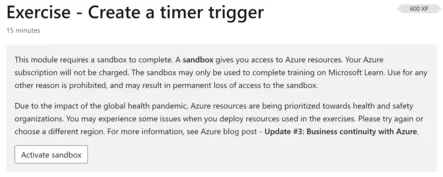
Here you can see the “Microsoft Learn Sandbox” subscription, which is used for the learning activities. It is only a temporary subscription and will disappear after a few hours, and more importantly means any resources used there don’t cost you anything.
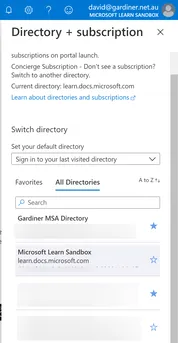
Here’s an example of a page using the Azure Cloud Shell. Many modules wil use bash, but this specific example is using PowerShell:

The modules will often check your work to confirm that you’ve followed the instructions correctly:
![]()
Also worth mentioning if you’d like some free instructor-led training then check out the Microsoft Azure Virtual Training Day: Fundamentals that are are being run during January and February. As a bonus, attendees will be eligible to take the Microsoft Azure Fundamentals certification exam for free! (Credit to Bronwen Zande for tweeting about this)
So if you’re looking to upskill, or just deepen your knowledge of Azure and GitHub then now is a great time to dive in.
8-Jan-2021 - Added screenshot of Azure cloud shell